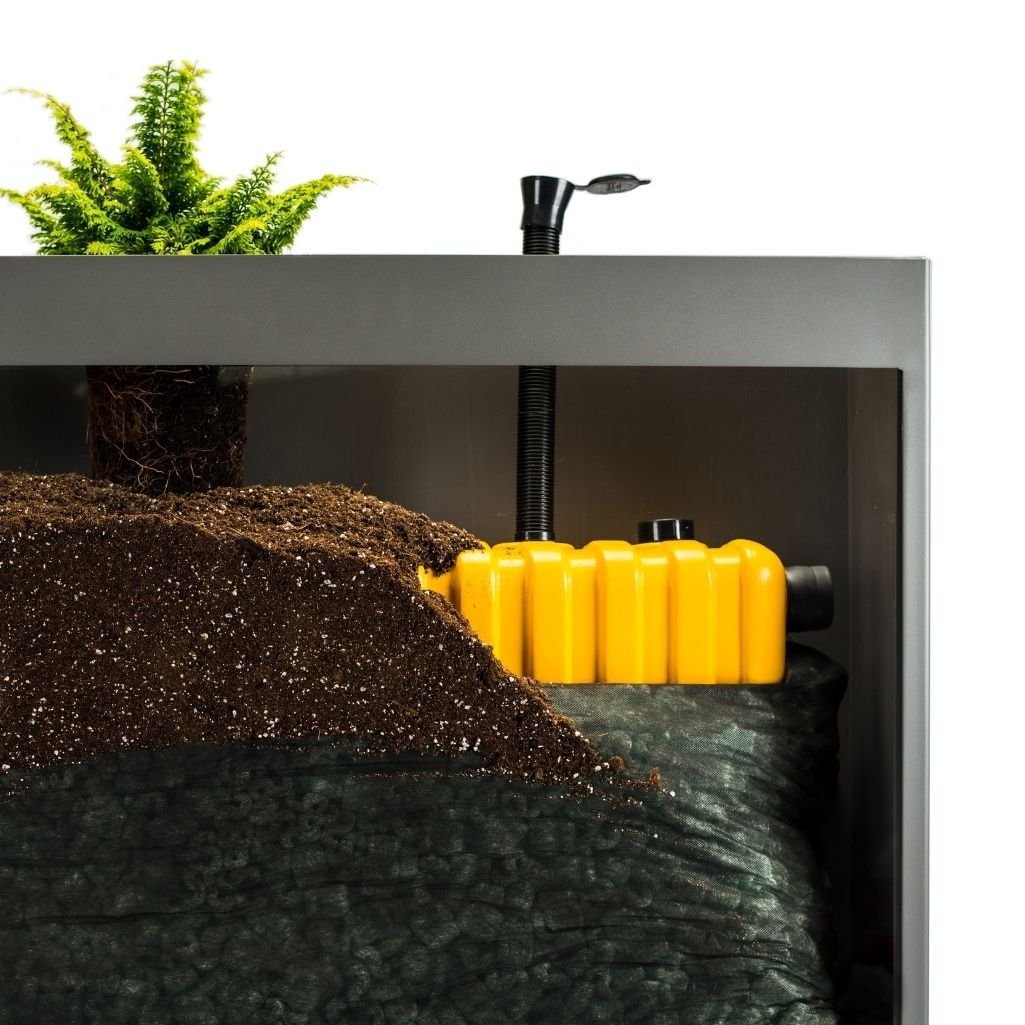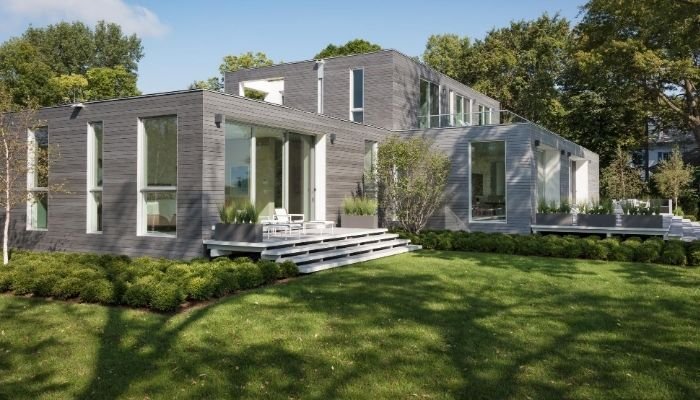Drainage for Plants: Why Is It Important
Everyone knows that plants need water to survive. After all, overwatering is a very common cause of death for plants. But not everyone understands just how critical air and proper drainage are for keeping plants healthy.
For many plants, excess moisture can cause root rot. When growing plants in pots, the goal is to find a planter that strikes a delicate drainage balance.
We recommend taking steps to increase drainage near the root zone and ensure no stagnant water accumulates at the bottom of the pot.
To optimize plant drainage, consider these best practices:
Double potting or using planters with detachable saucers
Adding gravel or rocks to expedite drainage
Placing plant risers at the base of your container to provide efficient air circulation under your pot and ward off disease
In this article, we’ll provide tips to avoid root rot and optimize plant and soil health by achieving proper drainage. You’ll find information for planters with and without drainage holes.
Importance of Drainage for Plant Health
Plants need water, but they also need air. When water doesn’t drain properly, the plant’s roots can’t access enough oxygen.
Proper drainage is critical to plant root health because, by allowing excess water to seep out after watering, you can ensure that water won’t pool at the base of your pot. This helps protect the plant’s roots from bacteria, fungus, and rot.
Overwatering can do severe damage. Over-saturated soil — or standing water in the bottom of your pot — can essentially drown your plants.
Unfortunately, your plants can't raise their hand and say, "I’ve had enough.”
The good news is that you can look for these clues of oversaturation:
Lower leaves are yellow
New leaves are brown
Once this happens, decay begins to spread throughout the soil and can quickly cause irreparable harm to the rest of the root system.
How to Optimize Plant Drainage
The best advice is to err on the side of caution and always ensure your plants — whether in pots, gardens, or raised beds — have proper drainage.
Planter with Drainage Holes
In the ideal situation, potted plants will thrive best in a planter with drainage holes. However, it’s important to note that even planters with drainage holes — if not properly designed and filled — can present a drainage problem.
However, it’s important to note that even planters with drainage holes — if not properly designed and filled — can present a drainage problem.
Below we recommend a few strategies for ensuring proper drainage for planters with drainage holes. Again, it’s important to note that none of these drainage strategies are “set it and forget it.” Regardless of the drainage strategy you select, be sure to check the plant from time to time.
Use a Detachable Saucer
For pots with permanently attached saucers, emptying any overflow can be difficult and even nearly impossible. Be vigilant about emptying out any excess water so your soil has an adequate opportunity to dry out and get some air.
Because draining excess water is vital for ensuring healthy plant roots, using a planter with a detachable saucer is safer.
Use Double Potting
To use this method, simply place your plant inside a larger — and perhaps more decorative — planter without disturbing the roots. This method also makes it easy and convenient to change the planting arrangement from time to time.
The problem with double potting, however, is that water can accumulate in the bottom of the larger container — even though the original plant container may have drainage holes.
To ensure proper drainage, check your plant often for standing water.
Use Gravel
Adding a layer of gravel or rocks can help with drainage. Excess water can drip down to the gravel.
Because water moves through gravel faster than it moves through soil, gravel can expedite the drainage process. This way, wet patches dry out more quickly, and your plant avoids sitting in water.
However, it’s important to note that gravel works best when inside the larger pot of a double potting scenario.
If the gravel is placed at the bottom of an individual pot, extra water can often “perch” or accumulate in the soil just above the gravel. Of course, that extra water can damage the plant.
Use Planter Risers
Solutions like using gravel and double potting aim to elevate the plant. Another similar solution involves plant risers such as the Lift N’ Level Kit. Made from recycled tires, these plant risers sit at the base of your container and provide efficient air circulation under your pot to ward off potential disease.
A nice benefit of the risers is that they prevent condensation. This helps protect the surface you’ve chosen to rest the planter upon.
Why Use Self-Watering Planters
Each drainage strategy described above involves some level of hands-on participation.
If plants are located at a beach house or country cottage — or in a commercial space that isn’t completely leased yet — there might not be time or resources for that kind of involvement with the plants. In that case, we recommend self-watering planters.
Sometimes referred to as sub-irrigation containers, self-watering planters draw water automatically from an internal reservoir.
There are a few ways this happens:
Capillary action (think of a paper towel wicking water) via soil columns
A fabric cord or rope wicks
A porous terracotta barrier
Moisture sensors
If the self-watering mechanism is effective, the plant receives the water it needs without becoming oversaturated.
You water your plants by simply topping up the reservoir. This way, you don’t have to check the soil or keep track of the moisture level of each plant.
It’s important to note that self-watering planters are not right for all plants. The following plants may need a different solution:
Plants that need to dry out. Succulents, thick-leaved cactus, orchids, and some other plants could experience root rot if constantly watered.
Plants located outdoors. If self-watering containers are located outside, they can easily become waterlogged by humidity and rain.
How to Improve Drainage in Planters, Decorative Pots, and Wraps without Drainage Holes
Planters with drainage holes won’t make sense for all design projects.
Some of our clients voice concern about drainage holes potentially overflowing and damaging expensive floors. The team at PureModern understands this concern and works carefully with our clients to develop the best solution.
Some solutions we recommend:
Create a cachepot for your client. Find a plastic pot with drainage holes that’s slightly smaller than your pot. Use the plastic pot to actually pot the plant. Then, set the plastic pot inside your decorative planter. You’ll be able to hide the plastic pot itself.
Insert a drainage layer. Add stones, pebbles, pumice, or activated charcoal to the bottom of the decorative pot before adding soil. This will enable any excess water to escape the soil and the roots to avoid damaging them.
Insert an internal shelf. When the design calls for a tall planter without drainage holes, you can create a custom planter by inserting an internal metal shelf. This will minimize the need for filling material and reduce the risk of water pooling at the bottom.
Soil Structure Needs for Proper Drainage
Whether you are using an indoor or outdoor planter or planting in the ground of your landscaped space, different plants have different soil structure needs.
Soil structure also plays an important role in laying the groundwork for successful drainage. So let’s first break down — in simple terms — what soil structure is:
When we talk about soil structure, we’re referring to the way soil particles are arranged.
Good soil structure will have wide empty spaces between the soil particles. These spaces enable air, water, roots, and various organisms to move around the soil easily.
Soil in a Planter
How you fill your planter will also impact drainage. When choosing potting soil for planters, it’s important to use soil that’s best suited to the plants you’ve selected for your landscape design.
For example, a snake plant prefers a light loamy potting mix that drains well. And while succulents like cacti also like a soil that drains well, these plants will grow best in a porous potting mix that combines sand, grit, and perlite. This kind of coarse mix enables the roots to dig down deep and establish a strong foundation.
We always recommend choosing a sterile commercial potting mix. While it might be tempting to simply scoop soil from an outdoor garden bed, that soil can be overly compacted and/or crawling with pests, bacteria, and disease.
Soil in a Landscaped Space
Planting directly into the ground of your landscaped space can be a bit more complicated than the controlled environment of a planter.
Some plants are very forgiving and will bloom wherever they’re planted. But others are more finicky, like Hydrangeas that will bloom more beautifully based on proper levels of acidity in the soil.
It is possible to optimize soil structure and drainage in your client’s landscape soil to achieve the ultimate blooms for that beautiful Hydrangea or those new raspberry bushes.
Depending on whether soil is primarily sand or clay, a few simple organic amendments can improve soil structure and drainage.
For Sand: Because there will typically be several air pockets between soil particles in sandy soil, drainage will be fast. Remember, we want not only to wick away water, but also retain the right amount of water for your plant. In this case, adding organic matter like compost, manure, or peat will help retain appropriate water levels.
For Clay: In clay-heavy soil, particles tend to be very close together. This means air levels are low and drainage is slow. In this case, it’s best to add organic matter that does not retain water — like fine fir or hemlock bark. These organic materials will help increase air pockets.
Learn More
If you’ve still got questions about how to choose a planter that will provide the right drainage solution for your design plan, contact us today. Our experts will be happy to help you find the perfect fit.




